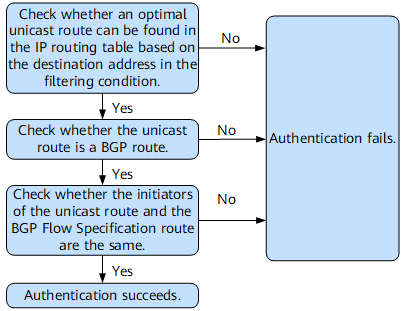Configuring Static BGP IPv6 VPN Flow Specification
In IPv6 VPNs, BGP IPv6 VPN Flow Specification routes are generated manually to control traffic in static BGP IPv6 VPN Flow Specification.
Usage Scenario
When deploying static BGP IPv6 VPN Flow Specification, a BGP IPv6 VPN Flow Specification route needs to be generated manually, and a BGP IPv6 VPN Flow Specification peer relationship needs to be established between the device that generates the BGP IPv6 VPN Flow Specification route and each ingress in the network to transmit BGP IPv6 VPN Flow Specification routes.
In an AS with multiple ingresses, a BGP IPv6 VPN Flow route reflector (Flow RR) can be deployed to reduce the number of BGP IPv6 VPN Flow Specification peer relationships and save network resources.
If you want to filter traffic based on the address prefix but the BGP IPv6 VPN Flow Specification route carrying the filtering rule cannot be authenticated, disable the authentication of BGP IPv6 VPN Flow Specification routes received from a specified peer.
Pre-configuration Tasks
Before configuring static BGP IPv6 VPN Flow Specification, configure a VPN instance and bind interfaces to a VPN instance.
Procedure
- Generate a BGP IPv6 VPN Flow Specification route manually.
- Establish a BGP IPv6 VPN Flow Specification peer relationship.
- (Optional) Configure a Flow RR.
Before configuring a Flow RR, establish a BGP IPv6 VPN Flow Specification peer relationship between the Flow RR with the device that generates the BGP IPv6 VPN Flow Specification route and every ingress.
- (Optional) Add the AS_Path attribute as a check item to BGP IPv6 VPN Flow Specification route verification rules.
- (Optional) Disable BGP IPv6 VPN Flow Specification route authentication.
- (Optional) Disable BGP FlowSpec protection.
Verifying the Configuration
After configuring static BGP IPv6 VPN Flow Specification, verify the configuration.
Run the display bgp flow vpnv6 vpn-instance vpn-instance-name peer [ [ ipv4-address | ipv6-address ] verbose ] command to check information about BGP IPv6 VPN Flow Specification peers.
Run the display bgp flow vpnv6 vpn-instance vpn-instance-name routing-table command to check information about BGP IPv6 VPN Flow Specification routes.
Run the display bgp flow vpnv6 vpn-instance vpn-instance-name routing-table [ peer { ipv4-address | ipv6-address } { advertised-routes | received-routes [ active ] } ] statistics command to check statistics about BGP IPv6 VPN Flow Specification routes.
- Run the display flowspec ipv6 rule reindex-value slot slot-id command to check information about combined rules in the BGP IPv6 Flow Specification route rule table.
- Run the display flowspec ipv6 rule statistics slot slot-id command to check statistics about the rules for BGP IPv6 Flow Specification routes to take effect.

